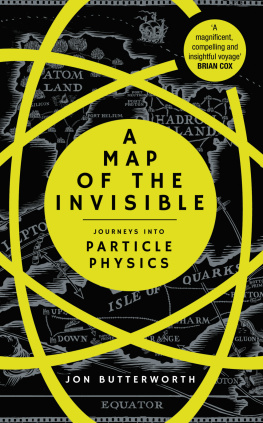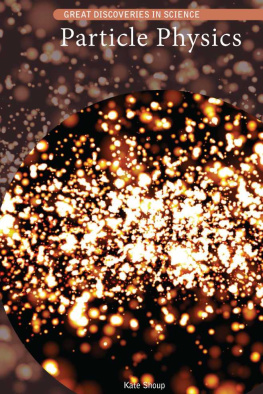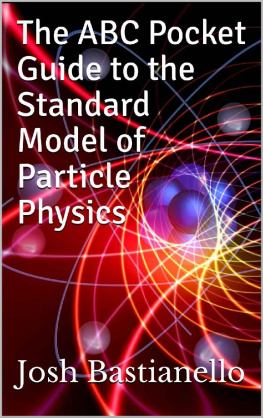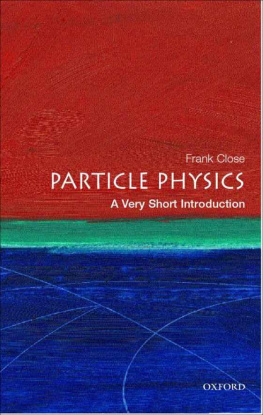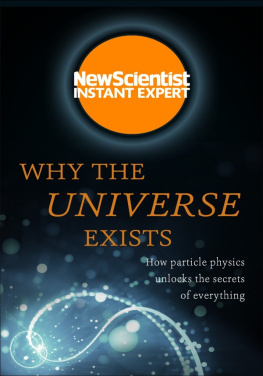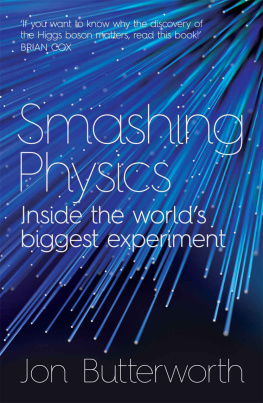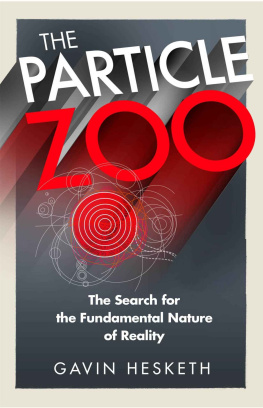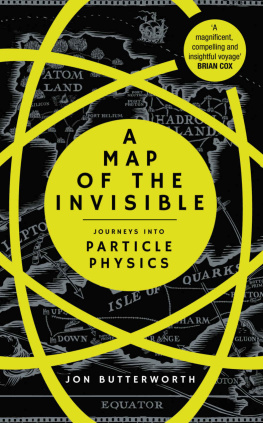Contents
About the Author
Jon Butterworth is currently Head of the Department of Physics and Astronomy at UCL and works on the ATLAS Experiment at CERN's Large Hadron Collider. He studied at the University of Oxford, receiving a DPhil in particle physics in 1992. He is the author of Smashing Physics, and of the Life and Physics blog for the Guardian. He lives in London.
About the Book
What is the universe really made of? How do we know? Follow the map of the invisible to find out
Over the last sixty years, scientists around the world have worked together to explore the fundamental constituents of matter, and the forces that govern their behaviour. The result, so far, is the Standard Model of elementary particles: a theoretical map of the basic building blocks of the universe. With the discovery of the Higgs boson in 2012, the map as we know it was completed, but also extended into strange new territory.
A Map of the Invisible is an explorers guide to the Standard Model and the extraordinary realms of particle physics. After shrinking us down to the size of a sub-atomic particle, pioneering physicist Jon Butterworth takes us on board his research vessel for a journey in search of atoms and quarks, electrons and neutrinos, and the forces that shape the universe. Step by step, we travel into the world of the unseen, discovering phenomena both weird and wonderful, from atoms to black holes and dark matter, and beyond, to the outer reaches of the cosmos and the frontiers of human knowledge.
Beautifully illustrated, with gradually evolving maps offering an inventive visual glossary as the journey progresses, A Map of the Invisible provides an essential introduction to our world, and to particle physics. It is a landmark work of non-fiction by one of the great scientists and science writers of today.
Acknowledgements
THE IDEA FOR the maps started with a talk I gave at the Royal Society, but was developed further in discussions with Tom Avery and Chris Wormell. Thanks also to Tom for patience and suggestions on the text, and Chris for patience with my suggestions on the maps. It was a pleasure working with both of you.
The support of Diane Banks and her team continues to be outstanding.
I am privileged to be part of UCL, a university which supports and encourages an amazing diversity of ideas and activities, in research, teaching and in the writing of books like this. I am grateful to my colleagues there, as well as to my colleagues in the great international community of particle physics.
The love and encouragement of my family is the crust, mantle and core that supports the entire map of my world.
Also by Jon Butterworth
Smashing Physics
Further Reading
HOPEFULLY THIS BOOK whets your appetite for more adventure. If so, then here are a few suggestions:
If you still have shaky sea legs, Chad Orzells How to Teach Quantum Physics to your Dog will give you much more on waves versus particles and all that. The description of QED in Expedition III owes a debt to a short popular book by one of its discoverers: Richard Feynmans The Strange Theory of Light and Matter is well worth reading if you want to hear more, from the horses mouth.
Janna Levins Black Hole Blues and Other Songs from Outer Space is a gripping account of the people (and the persistence) behind the discovery of gravitational waves described in Gravity: A Distant Diversion. Graham Farmelos biography of Paul Dirac, The Strangest Man, is full of moving and enthralling insights into a great breakthrough and a too-little-known genius. Brian Cox and Jeff Forshaws Why does E=mc2? is a great way to get to grips with more of the ideas behind relativity, and Universal will show you how to begin expeditions of your own, even without a Large Hadron Collider to hand. Sean Carrolls Particle at the End of the Universe gives a good account of particle physics up to and including the discovery of the Higgs, as does Gavin Heskeths The Particle Zoo (and of course Smashing Physics tells you a bit more about the discovery itself). Finally, Lisa Randalls Dark Matter and the Dinosaurs has the true flavour of some of the stories we heard in the dockside bars.
Contents
This ebook is copyright material and must not be copied, reproduced, transferred, distributed, leased, licensed or publicly performed or used in any way except as specifically permitted in writing by the publishers, as allowed under the terms and conditions under which it was purchased or as strictly permitted by applicable copyright law. Any unauthorized distribution or use of this text may be a direct infringement of the authors and publishers rights and those responsible may be liable in law accordingly.
Epub ISBN: 9781473537705
Version 1.0
Published by William Heinemann 2017
1 3 5 7 9 10 8 6 4 2
Copyright Jon Butterworth 2017
Map illustrations Chris Wormell
Cover atom icon Getty Images
Jon Butterworth has asserted his right under the Copyright, Designs and Patents Act, 1988, to be identified as the author of this work.
First published in Great Britain in 2017 by William Heinemann
William Heinemann
The Penguin Random House Group Limited
20 Vauxhall Bridge Road, London, SW1V 2SA
www.penguin.co.uk
William Heinemann is part of the Penguin Random House group of companies whose addresses can be found at global.penguinrandomhouse.com
A CIP catalogue record for this book is available from the British Library
ISBN 9781785150937
To Ann and Keith
A Note on the Maps
THE MAPS WITHIN this book should be seen as an aid to memory, rather than a detailed representation of particle physics. There is a rough direction of increasing energy (and decreasing size) from west to east, and increasing complexity from south to north, but there are grey areas and ambiguities. Sometimes the energy scale is binding energy, sometimes mass, and there are unavoidable inconsistencies even so. For example, the photon belongs on Bosonia in the east, even though its presence is felt far to the west. The tau and muon should arguably be further east than the up, down and strange, based on their masses, although one does really have to cross Lamdba QCD to get to the quarks. Allegory and analogy can help understanding, but are misleading if pushed too far. Enjoy yourself but tread with care.
PROLOGUE
The Journey Begins
CONSIDER A THOUGHT experiment: take an apple and cut it in half, then cut it in half again, and again, and keep doing that. What will you end up with?
Or, less destructively, peer more and more closely into an apple: what structure is revealed? Is everything made up of a small set of common constituents call them elements, or atoms arranged in various different ways? If so, what happens if I look more closely at those constituents? Are they made of something even smaller?
What is eventually revealed is a landscape. A landscape inhabited by strange and wonderful particles. In this landscape are islands of complexity linked by networks of communication, emerging from the oceans of our ignorance. The landscape starts from everyday life, with an apple, for example, and extends to the wild frontier of the almost impossibly small.

